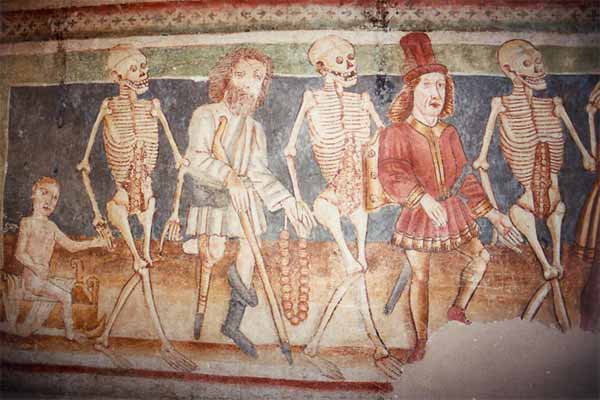
Camille Saint-Saëns one of the great Romantic composers was inspired by the old French legend “La Danse Macabre” which has been translated to the “Dance of Death”. This legend consists of various dead people from all walks of life but generally include a laborer,child and a king dancing at midnight on Halloween to the devil’s fiddle (which has been changed in the piece to a violin) before returning to their graves. This was commonly used as a memento mori in the middle ages to show the universal nature of death and that nothing on earth can deny any one of us the same fate. Here the composer took this allegory and built one of the greatest pieces in the history of music. The song is incredibly complex and would require an incredible amount of work to completely dissect, for the sake of clarity let us look at the opening passage before the composition spirals into insanity with the use of counterpoint and dramatic orchestration.
The violin’s tuning is changed so that the tritone (devil’s interval) can be played on the open strings.
a single note from a harp is hammered into the listener’s mind twelve times representing the twelve strikes of a church bell at midnight. At the end of the twelve strikes the violins play the notes of a D major chord for a moment of serenity. On the violin one doesn’t tend to play chords so each violin will play a single note of the chord though the orchestration of how each note is represented depends a lot on the interpretation of the piece.
Small steps that break the serenity of the D major chord as the dead begin to rise from their graves, these simple arrpegios that aren’t quite resolved lead towards the dissonant open string attack that allows the violinists to play the tritone in a syncopated rhythm to add tension and to show the horror of the dead.
Theme A is introduced on a flute played mezzo piano (fairly quietly) before the violins attack back with the same theme in a call and response manner. This melody is built from the previous intriguing melody and serves to build up to the grandiose theme B. A solo violin plays theme B which is the central motif of this composition and simply one of the greatest melodies in the history of music as it completely encompasses the beauty of life through the certainty of death. Both morbid and elegant. A pizzicato staccato rhythm is played underneath similar to the palm muting technique on the electric guitar and creates intrigue like the previous footsteps melody to create momentum for an initial release.
An oboe and bassoon then develop theme A with more panache than the flutes and push this piece further towards its climax as it is now obvious that theme A serves to generate momentum for theme B which is the devil playing his fiddle for the dead to dance. the violin then reprises its role in the responding to the oboe and bassoon but continues in developing theme A so that the momentum is not cut.
The dissonant open string attack returns to remind the listener that while this may be a dance for the devil and the dead, for the listener it shall remain a harrowing experience. the violins then return to theme A in its initial form and at this point it is played with a certain amount of intensity while transposed to accommodate for the wood based instruments as everything will lead into theme B as an initial climax. Theme B is now in full force and also played in unison an octave higher for a fuller sound.
The single violin returns to play the second iteration of theme A as Saint-Saëns will now evoke the skeletons dancing with a development on theme A played by xylophones in order to replicate the sound of the bones. All the ideas of this composition have been introduced and excellently developed but this is only the beginning as the song goes through a long development process before reaching an unbelievable conclusion with the dissonant tritones marking the end of the first passage.
Judging Romantic music on the same merits as metal and vice-versa is harmful and degrading to both genres. Though there are similarities between the two, both seek to achieve different objectives. On this piece we approach the themes that metal bands would choose to adopt a century later and can see the similarities emerge between the two yet we must remain wary as to not overemphasize them. Metal would take the use of dissonance much further while opting for much more streamlined arrangements based on pure emotion but at the cost of a greater sense of dynamics and this sense of dynamics over the supremacy of death will make this composition an integral part of the human legacy.


That’s a hot little article you’ve written Nikki boi
you remind me of Maximilian Pegasus
Yu-Gi-Oh! references are cult
What does a children’s cartoon character based on a children’s game where you sling colorful pieces of cardboard around on a table have to do with this?
As a young millenial Yu-Gi_Oh! was an essential cartoon and you remind me of this https://www.youtube.com/watch?v=bn3mNg-CeAo
Bravo!
It is moving that we finally get passionate, formally trained musicians doing analysis of dark classical music in an underground metal website. Also, and mainly because of the light it brings to dark underground music metal and ambient.